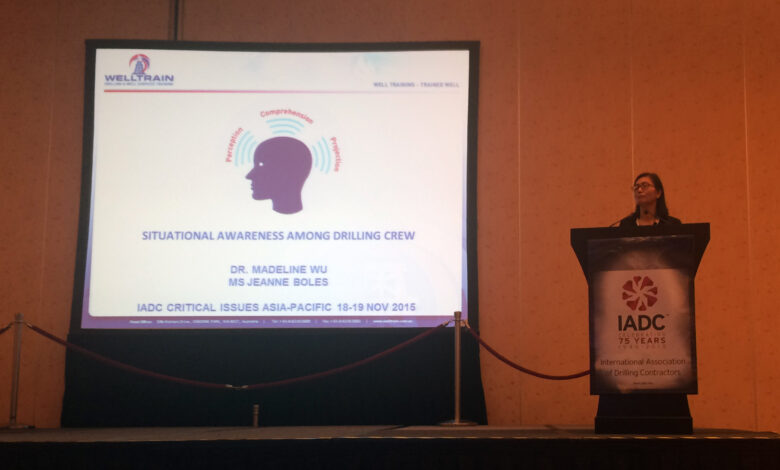Situation awareness is cornerstone to safety culture but is still not well understood

By Linda Hsieh, Managing Editor
As human factors are increasingly recognized as playing a critical role in drilling safety and performance, the term situation awareness has also become more widely discussed. However, compared with other core non-technical skills, situation awareness remains the least understood, Dr Madeline Wu, Human Factors Specialist and Industrial Psychologist with Australia-based Welltrain, said. “You’ll find that readings on other topics such as teamwork, decision making, leadership, communication and stress are already covered in textbooks on organizational behavior. You’ll find limited layman readings on safety and situation awareness, which is a pity because situation awareness is the cornerstone of forming a safety culture,” she said at the 2015 IADC Critical Issues Asia Pacific Conference on 19 November in Singapore.
Layman terms to describe situation awareness include alertness, concentration and maintaining vigilance, Dr Wu explained. It also means being aware of the environment around you, such as wellbore status, potential dropped objects, the task at hand, as well as having an understanding and awareness of the mental and physical fitness of people around you.
Lessons learned from high-profile incidents such as Macondo have already driven industry groups to establish guidelines around well operations crew resource management. Reports 476, 501 and 502 from the International Association of Oil and Gas Producers especially have thrust human factors and the need for better non-technical skills training into the spotlight. Particularly in an offshore environment, Dr Wu said, good situation awareness can lead to improved decision making and become critical when responding to abnormal situations when a timely response is required.
The 3 levels of situation awareness are:
- Perception is the ability to see what is going on around you, being on the alert to what is going on, and being able to answer questions.
- Comprehension means understanding what you “see” and its impacts on the task at hand.
- Projection, which involves predicting the future state based on what the individual operator believes is the current state and forward planning, such as doing calculations and preparing equipment.
Multiple factors can affect situation awareness:
- Informational influences
- Ability to integrate information from multiple sources, such as data displays from screens and gauges;
- Environmental influences
- Wind gusts
- Dropped objects potential
- Reduced visibility during darkness
- Personal influences
- Fatigue
- Stress,
- Experience
- Motivation
- Abilities
- Knowledge
- Organizational influences
- Unrealistic work loads
- Distractions
- Training
- Information, such as the shift handover structure
An analysis of 135 drilling activity incidents from an international oil company’s database showed that 67% of situation awareness errors occur at level 1, Dr Wu said. “Most of these errors occur through a failure to monitor or detect information that was available to the operators. The main causes of level 1 situation awareness errors include distractions, tunnel vision, stress, fatigue and high work load.”
Rig crews can help to monitor for diminished situation awareness among their colleagues, however, and help to reduce potential errors. “You could look for blank glazed expressions, anxiety, confusion, withdrawal from others,” she said. Other signs of diminished situation awareness include failure to follow standard operating procedures, poor communication, a drop in work standards and a focus on non-critical activities. “When you recognize any of these signs, it’s advisable that you remove your colleagues from performing safety-critical tasks.”




